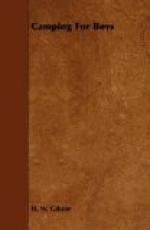The illustrations opposite show a device by which a camp, baseball grounds, running track, tennis court or any distance may be quickly and accurately measured. The first thing to do is to get an inch board and cut a round disc (a) about 12 inches in diameter. Cut two of them and tack them together. The diagram “b” is easier to cut out and will serve the purpose just as well. When the two are temporarily tacked together, bore a hole through the centre for the axle. The eight spokes should be of light material and not too pointed or they will sink in the ground and prevent accuracy. The spokes are tacked on one disc as shown in “c” and then the other disc is nailed on the outside.
[Illustration: A Measuring Device]
Paint the end of one spoke red, so that you can count it every time it comes around. By having the points that touch the ground exactly 9 inches apart, one revolution of the wheel will measure six feet. For an axle use a small piece of broom handle, and for a handle use a long light pole. By varying the length of the spokes you can make the wheel measure any desired distance.
Wall Tent
The line of the camp having been laid out, the next thing is the erection of the tents. The best way of setting up a wall tent (either the 12 x 14 or 14 x 16 size), the type used in most of the boys’ camps, is the method used by the army and described in Kephart’s “Book of Camping and Woodcraft.” Four boys or men proceed as follows: Nos. 1 and 2 procure canvas, and Nos. 3 and 4 the poles.
Nos. 3 and 4 lay the ridge pole on the ground, in the direction that the tent is to stand; then lay the uprights at each end of ridge-pole and at right angles to it, on the side opposite that from which the wind blows. Then drop the tent pins and hammers at their respective ends of the tent; then drive a pin at each end of the ridge to mark front and rear. Meanwhile Nos. 1 and 2 unroll the tent and spread it out over the ridge-pole and on both sides of it.
Nos. 1 and 3 now go to the rear, and Nos. 2 and 4 to the front, and slip the pins of the uprights through the ridge-pole and tent. If a fly is used, it is placed in position over the tent, and the loops of the long guys over the front and rear pole pins. No. 4 secures center (door) loops over center pin in front, and No. 1 in rear. Each goes to his corner, No. 1 right rear, No. 2 right front, No. 3 left rear, No. 4 left front.
All draw bottom of tent taut and square, the front and rear at right angles to the ridge, and fasten it with pins through the corner loops, then stepping outward two paces from the corner, and a pace to the front (Nos. 2 and 4) or rear (Nos. 1 and 3) each securely sets a long pin, over which is passed the extended corner guy rope. Care must be taken that the tent is properly squared and pinned to the ground at the door and four corners before raising it.
[Illustration: Shelter Tents, Seton Tepee, Tent Made Of A “Fly”, Wall Tent]




